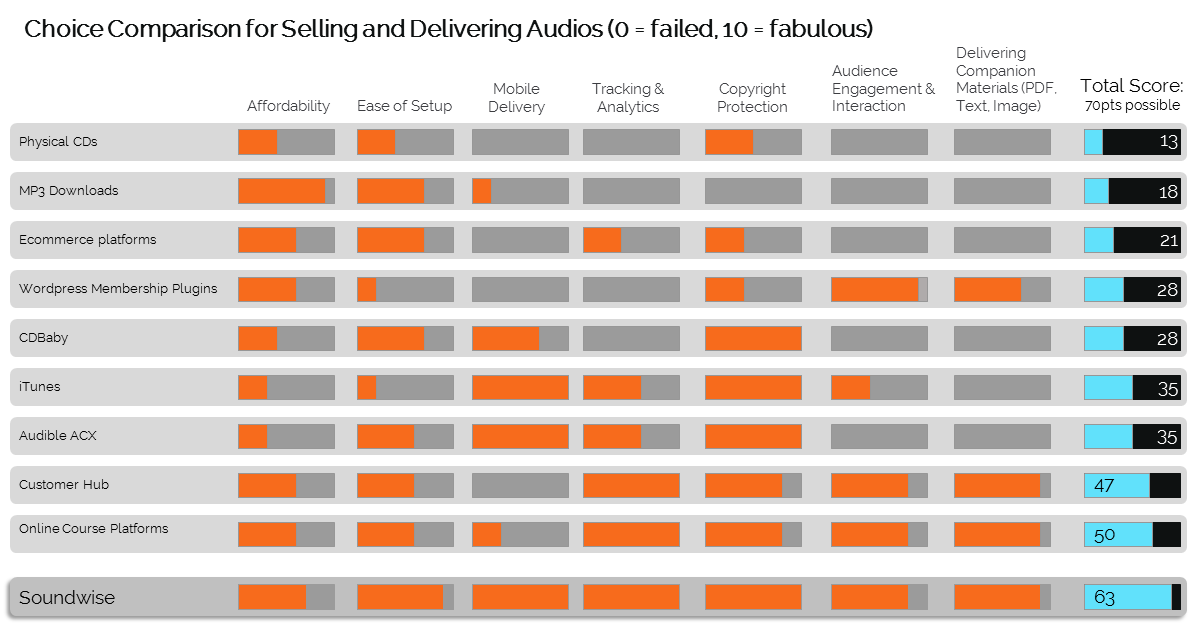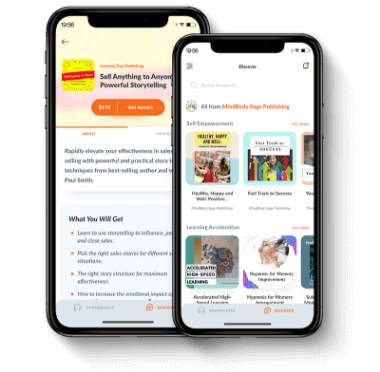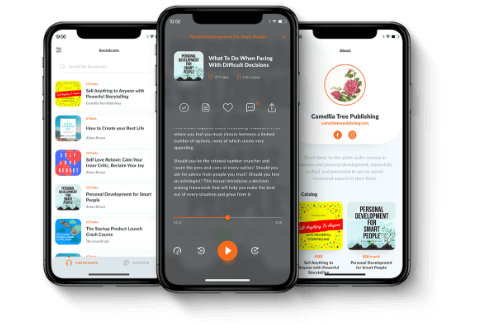On-demand audios, such as podcasts, audio courses, and audio books, have seen huge growth in demand in recent years. Audio content allows the increasingly mobile population to absorb knowledge and information on the go and while multitasking. If you’re a coach, trainer, or on-line entrepreneur, on-demand audio courses and products can be one of the best ways to package and sell your knowledge.
Whether you use your audio products to deliver education material or to provide inspiration and motivation, you need to choose the right tool to get your audios easily into the hands of listeners and students.
In this article, we research and compare 10 of the most popular tools and solutions for selling and delivering audio content.
1. iTunes
iTunes is perhaps the most commonly known way for musicians and artists to sell audio content. On iTunes, your content is sold in the form of albums. You may check out iTunes’ application page and see if you’re qualified to work with them directly-- however, the requirements for this are steep, such as having at least twenty albums in your catalogue. And iTunes normally doesn’t approve spoken-word audio content.
If you’re unable to work with iTunes directly, you can go through an Apple-approved aggregator such as CDBaby or TuneCore. Once you’re set up with an aggregator, you can upload original images and audio files. Audio files must fit specific settings, such as a sampling rate of 44.1Khz and 16-bit or 24-bit resolution.
It’s not only a complicated process. iTunes also places various restrictions on your content, for example, limiting the price point at which your audios can be sold for. The cost can be high for individuals, as iTunes takes 30% or more from all sales, meaning that you will receive $6.50-$7 for your album that’s listed at $9.99. In addition, there’s no way to deliver supplementary materials along with your audios, which can be important value-added and a price booster for educational content.
On the plus side, it’s iTunes! There is a certain aura of prestige that is projected when your content is associated with such a large and well-known platform.
2. Audible’s ACX Program
ACX, a.k.a. Audiobook Creation Exchange, is the audiobook publisher Audible’s publishing platform for independent audio creators. ACX allows you to sell audiobooks through Audible, Amazon, and iTunes. As a marketplace, it offers the opportunity for Rights Holders (authors, publishers, literary agents) to connect with narrators, recording studios, and other Producers. In the marketplace, Rights Holders and Producers come together to produce finished audiobooks. If you are a Rights Holder, you can choose to produce your audiobook on your own or through engaging with a Producer If you already have created an audiobook that you are interested in selling, ACX can help with that as well.
The downside is that like iTunes, ACX takes a high percentage of commissions. If you are the Rights Holder, you only receive 25-40% of retail sales of your audiobooks. And depending on the option you choose, you may be limited exclusively to sales on Audible. The potential benefit of additional exposure needs to be weighed against the high commission of ACX. In addition, with ACX, it is difficult to track and analyze how your content is listened to, and there is no option for delivering companion materials.
On the plus side, joining the ACX gets your audio content on Amazon, which may give your content additional exposure to new customers, given that Amazon is the largest online marketplace in the world. However, it’s not very likely that your audio content will be “spontaneously” discovered on Amazon by a substantial number of new listeners, without your own active promotion and effort to drive traffic to your content.
So if you want to sell your audio content at a premium price and actually reap the reward of your hard labor, ACX is not likely the right choice. This is especially true if you have at least some existing audience for a start and are able to promote and market your own content.
3. Online Course Platforms
Learning management softwares for delivering online courses, such as Teachable or Thinkific, offer another option for selling and delivering audio programs. These platforms allow users to conveniently create and deliver multimedia courses under their own brand, and in exchange, they charge a monthly fee for using the software.
The online course platforms are most ideal for delivering video-based content, which audiences consume from a computer. You can definitely use them to deliver audio content. However, you would be almost completely missing the benefit of the audio medium, i.e., allowing audiences to consume content on the go while multitasking.
4. WordPress Membership Plugins
WordPress is the most popular content management platform on earth, and allegedly powers 20% of the Internet. If your website is already built on WordPress, there are several plugins you can choose from that allow you to add a membership feature to your site. The notable ones in this category include WishList members, BuddyPress, MemberPress, PaidMembershipPro, and WooCommerceMemberships.
These plugins enable community building with messaging, member profiles, and user groups. You can charge people for joining your community. And behind the paywall of your membership site, you can make premium content, including audios, available to your members.
While a membership plugin can be a great addition to your WordPress site, they are mostly web based and do not offer mobile delivery, thus, again, missing the benefit of audio content. It can also be difficult to host and organize your content within the WordPress site. In addition, the setup cost for customizing the plugin to fit your specific needs can be high, if you’re not an already experienced WordPress developer.
5. E-Commerce Platform
E-commerce platforms such as Shopify provide the convenience to set up your own online shop and to sell anything you want, including audio content. With this option, you can create your own online storefront, where you can track sales, manage products, and fulfill orders. Shopify offers a variety of storefront themes and the ability to acquire a custom domain name.
The downside of this option for audio content is obvious. Your online shop is a storefront only. It doesn’t provide the actual audio material delivery, which means you will need to set up the management and delivery of your content in other ways after people make a purchase.
Gumroad is another popular E-commerce platform that aims to be an all-in-one solution for creative people to sell their work. It offers a simple setup and in-depth analytics so you can keep track of your business growth. However, just like Shopify, Gumroad is not a content delivery platform and can only be used for selling. You will still need to find another solution to deliver your audios to your customers on top of any E-commerce platform you use.
6. Infusionsoft’s Customer Hub
Customer Hub is a cloud-based software tool that allows people to build membership sites where they can upload and share multimedia content with subscribers. You can link your membership site to your business website, and generate and manage recurring revenue. The platform can be a convenient content delivery choice for you, if you’re already using other Infusionsoft products.
However, Customer Hub is web-based only. It does not offer mobile delivery, which as we’ve already discussed, is essential for audio content. The primary strength of the platform is to help you manage back-office operations such as billings, subscriptions, and deactivations.
7. CDBaby
CDBaby is traditionally a distribution platform for audio CDs, though in recent years, they have also added the option for selling digital downloads. As an online record store, it sells songs and distributes royalties, and can provide an easy distribution route for musicians who are just getting started. Although it is well known for music, CDBaby also supports the selling and distribution of spoken-word audio content.
Interested users can create an account. Then there is a submission process, when you may upload audio files and pay for your submission. Once you complete the process, CDBaby’s inspection team will review your submission and ensure that it meets their requirements.
While CDBaby offers an option to email subscribers, there are no audience interaction features. There is also no way to track or analyze your listeners. It is also impossible to add any text or PDFs that are supplementary to your audio content.
8. Physical CDs
Physical CDs are the “good old way” for selling and delivering audio content. While most people may consider CDs to be out of style, the older generation may like the fact that there is something physical that they can hold on to. This physicality means that CDs are not as easy to deliver as audio downloads or streaming. Selling them will likely require a physical inventory, and there are shipping and handling costs involved. In a fast-paced world where customers are used to getting the content they purchase right away, CDs are not ideal.
CDs also do not allow audience interaction. There is no way for adding supplementary materials. It’s impossible to gather listener analytics.
Unless your target audience is 50 years old and above, CDs are probably not the best option for delivering your audio content. But if this is the route you want to go down, here are some options for packaging and producing your CDs for sale: DiscMaker will help you directly mail bulk CDs, and CDBaby offers disc packaging options that include wallets, jackets, jewel cases, and digipaks. Oasis is another option. It aids with audio extras such as deluxe slipcases, and includes promotional items such as download codes and flyers.
9. Direct MP3 download
Mp3 downloads are another traditional way to deliver audio content. It’s straightforward to set up. All you need is a place to store audio files online and allow your customers to access the files via a URL link. Popular options for storage include your own website server, Google Drive, Dropbox, and Amazon S3. To sell and deliver your audios this way, you will need to configure the download page to be sitting behind a paywall. For example, you can set up a storefront using one of the ecommerce options we mentioned, and then send your listeners Dropbox or Google Drive links for download after they make the payment. With audio downloads, the content is available immediately on your listeners’ computer. The files are portable, though it does require your customers to transfer and organize the files into their mobile devices themselves.
The big drawbacks with MP3 downloads are that the audience will own the files once the content is purchased. That means it’s difficult to charge subscription fees. There is also a risk that your copyright may be infringed upon, as people can freely copy and transfer your files to others without you knowing about it. Besides, there is no way to track listening analytics.
10. Soundwise
Soundwise is a mobile-focused platform for coaches, experts, and entrepreneurs to sell and deliver on-demand audio content. Your audios on Soundwise are organized into “soundcasts.” Each soundcast is a collection of audio tracks. You can think of each soundcast as an album, an audiobook with chapters, a podcast with episodes, or an audio course with sections. It provides a flexible way to package and sell your audios.
You can choose to sell your audios as one-time, rental, or subscription products. And by bundling different soundcasts together, you can even offer your listeners your own subscription-based “Spotify.”
Soundwise is a one-stop solution for selling your audios, from hosting files, to payment processing, to mobile delivery. As we already mentioned, adding supplementary materials to your audios, such as PDF worksheets and reading materials, can provide additional value to your listeners and allow you to sell your audios at a premium price. With Soundwise, you can easily deliver supplementary materials along with your audios.
When listeners sign up for your soundcasts, either from the web or from the Soundwise mobile app, the content is immediately available in their account on the app, without them having to transfer or download any files.
To help you gauge what your audience wants in order to produce better content, Soundwise allows you to track all of the listenings from your customers. You can also engage your listeners by responding to comments, questions, and sending group messages through the app. It helps to build a sense of community and increase your customer loyalty.
However, the biggest value of Soundwise actually lies in the convenience it offers for people to purchase more audio content from you. When you have multiple soundcasts for sale, customers who bought one soundcast from you can purchase additional ones with only one tap, right from their phone, in the moment of inspiration as they listen to your content. It boosts the lifetime value you receive from each of your existing customers. That alone may increase your audio sales by at least 15 to 20%, without any additional marketing.
To help you compare the different options for selling audio content, in the table below, we evaluated each option against a set of essential criteria:
The Conclusion
When it comes to deciding which solution is right for you to sell and deliver audio programs, there are many factors to consider, from cost, to ease of use, to tracking and analytics.
No matter whether you’re just starting out or are an experienced audio content creator, Soundwise is likely the best solution for you. It is optimized for delivering spoken-word and educational content. Soundwise also gives you all the pieces you need for selling and delivering audios, and most importantly, helps you sell more by giving your listeners the opportunity to purchase directly from their phone. Rather than worrying about the tech, Soundwise helps you to focus your time and energy on creating and marketing your content, so that you can build a viable stream of income with your audios and impact more people’s lives.







